Aptitude-Treatment Interaction (ATI) Research: Individual Differences
VerifiedAdded on 2020/05/04
|14
|4289
|41
Essay
AI Summary
This essay delves into the concept of Aptitude-Treatment Interaction (ATI), a framework exploring how instructional strategies interact with individual learner aptitudes. It begins by defining ATI and outlining its core goals, which include aligning teaching methods with student abilities to optimize learning outcomes. The essay then identifies weaknesses in ATI research, such as a limited focus on social aspects of learning and the challenges in accounting for the dynamic nature of abilities. It highlights individual differences, particularly focusing on intelligence and its various facets, including analytical, creative, and practical intelligence, and their implications for learning. Furthermore, the essay discusses how teachers can identify student differences and modify instruction to maximize learning, ultimately recommending adjustments to teaching methods to accommodate diverse learning styles and aptitudes to improve language acquisition. This essay is a valuable resource for students on Desklib, a platform providing past papers and study tools.
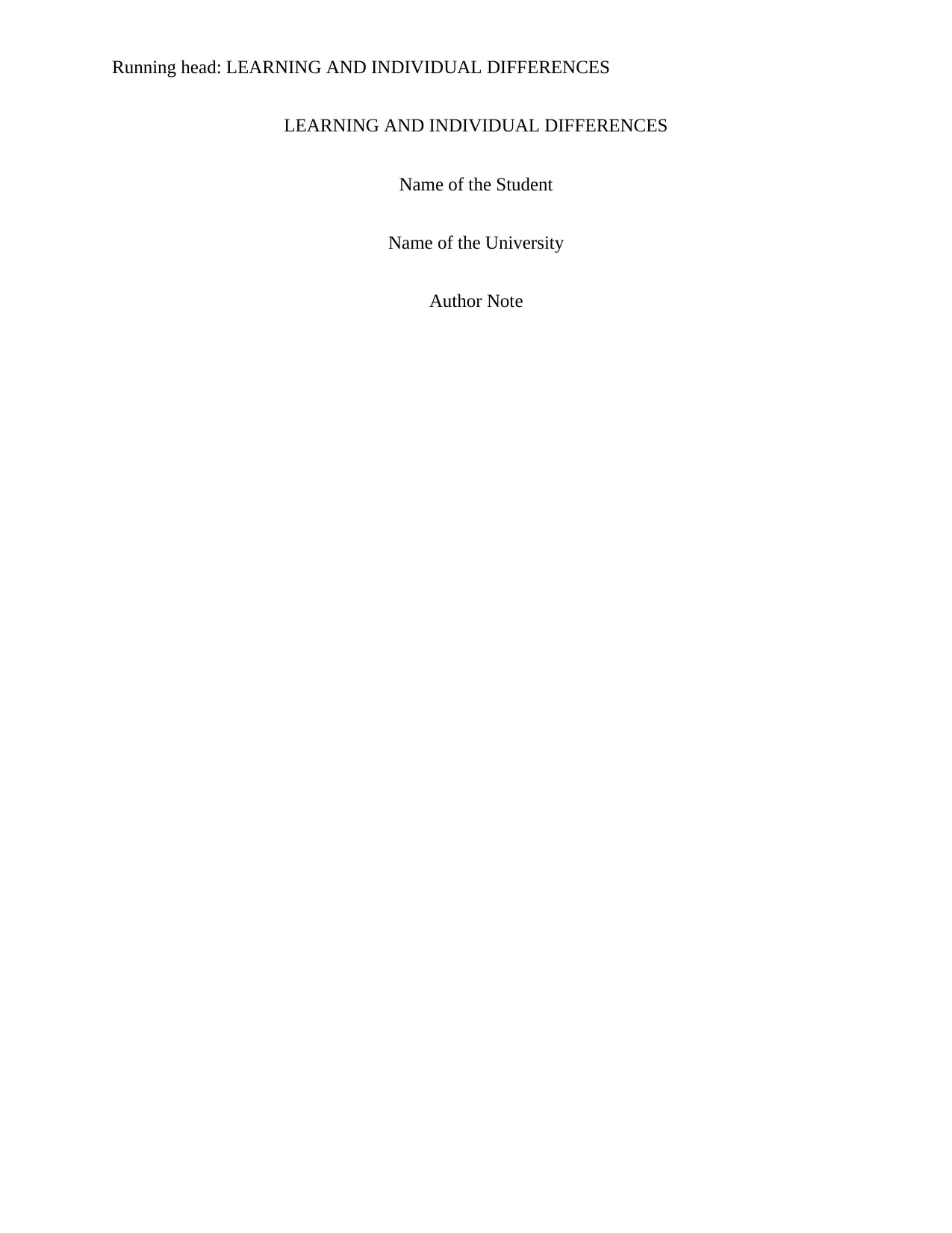
Running head: LEARNING AND INDIVIDUAL DIFFERENCES
LEARNING AND INDIVIDUAL DIFFERENCES
Name of the Student
Name of the University
Author Note
LEARNING AND INDIVIDUAL DIFFERENCES
Name of the Student
Name of the University
Author Note
Paraphrase This Document
Need a fresh take? Get an instant paraphrase of this document with our AI Paraphraser
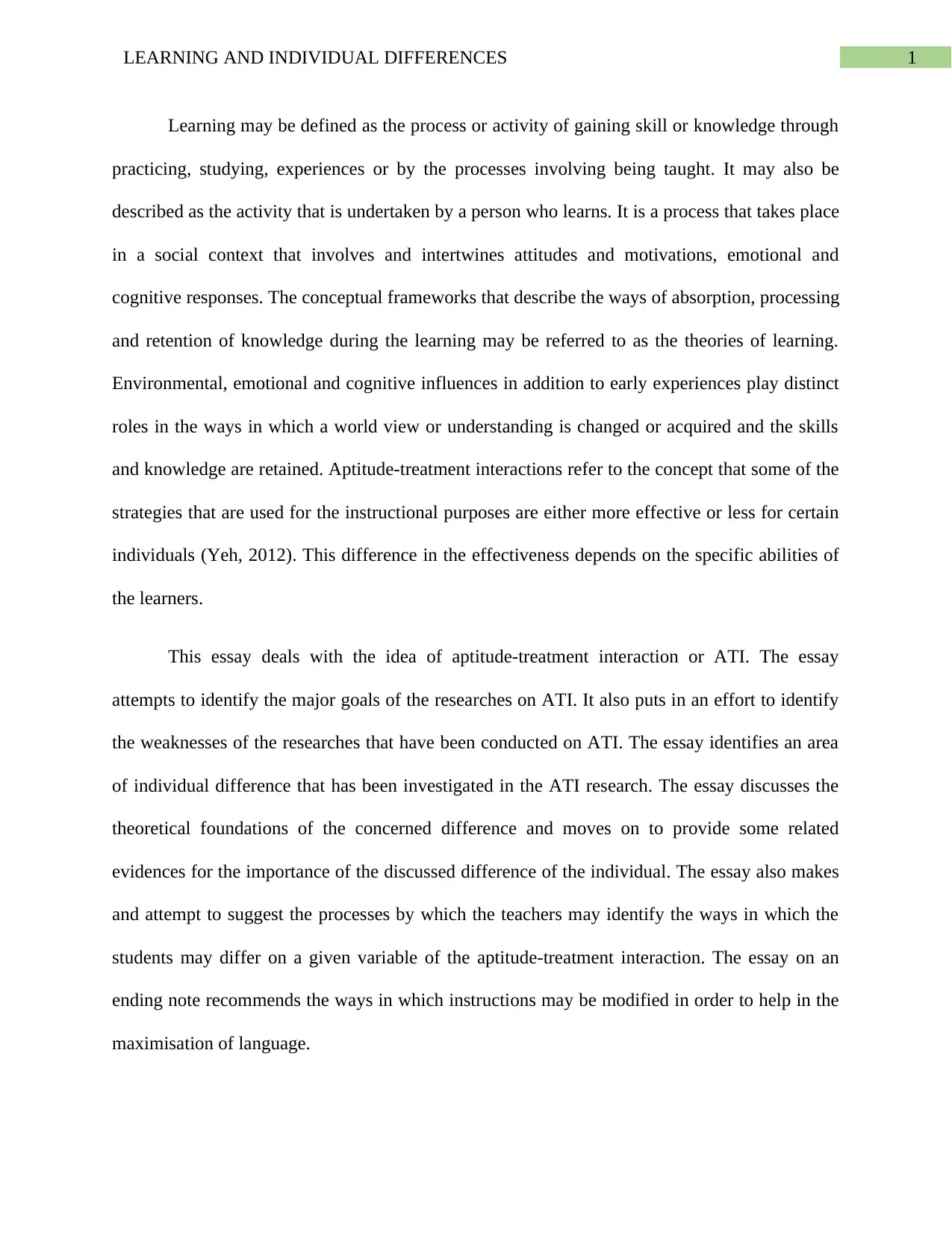
1LEARNING AND INDIVIDUAL DIFFERENCES
Learning may be defined as the process or activity of gaining skill or knowledge through
practicing, studying, experiences or by the processes involving being taught. It may also be
described as the activity that is undertaken by a person who learns. It is a process that takes place
in a social context that involves and intertwines attitudes and motivations, emotional and
cognitive responses. The conceptual frameworks that describe the ways of absorption, processing
and retention of knowledge during the learning may be referred to as the theories of learning.
Environmental, emotional and cognitive influences in addition to early experiences play distinct
roles in the ways in which a world view or understanding is changed or acquired and the skills
and knowledge are retained. Aptitude-treatment interactions refer to the concept that some of the
strategies that are used for the instructional purposes are either more effective or less for certain
individuals (Yeh, 2012). This difference in the effectiveness depends on the specific abilities of
the learners.
This essay deals with the idea of aptitude-treatment interaction or ATI. The essay
attempts to identify the major goals of the researches on ATI. It also puts in an effort to identify
the weaknesses of the researches that have been conducted on ATI. The essay identifies an area
of individual difference that has been investigated in the ATI research. The essay discusses the
theoretical foundations of the concerned difference and moves on to provide some related
evidences for the importance of the discussed difference of the individual. The essay also makes
and attempt to suggest the processes by which the teachers may identify the ways in which the
students may differ on a given variable of the aptitude-treatment interaction. The essay on an
ending note recommends the ways in which instructions may be modified in order to help in the
maximisation of language.
Learning may be defined as the process or activity of gaining skill or knowledge through
practicing, studying, experiences or by the processes involving being taught. It may also be
described as the activity that is undertaken by a person who learns. It is a process that takes place
in a social context that involves and intertwines attitudes and motivations, emotional and
cognitive responses. The conceptual frameworks that describe the ways of absorption, processing
and retention of knowledge during the learning may be referred to as the theories of learning.
Environmental, emotional and cognitive influences in addition to early experiences play distinct
roles in the ways in which a world view or understanding is changed or acquired and the skills
and knowledge are retained. Aptitude-treatment interactions refer to the concept that some of the
strategies that are used for the instructional purposes are either more effective or less for certain
individuals (Yeh, 2012). This difference in the effectiveness depends on the specific abilities of
the learners.
This essay deals with the idea of aptitude-treatment interaction or ATI. The essay
attempts to identify the major goals of the researches on ATI. It also puts in an effort to identify
the weaknesses of the researches that have been conducted on ATI. The essay identifies an area
of individual difference that has been investigated in the ATI research. The essay discusses the
theoretical foundations of the concerned difference and moves on to provide some related
evidences for the importance of the discussed difference of the individual. The essay also makes
and attempt to suggest the processes by which the teachers may identify the ways in which the
students may differ on a given variable of the aptitude-treatment interaction. The essay on an
ending note recommends the ways in which instructions may be modified in order to help in the
maximisation of language.
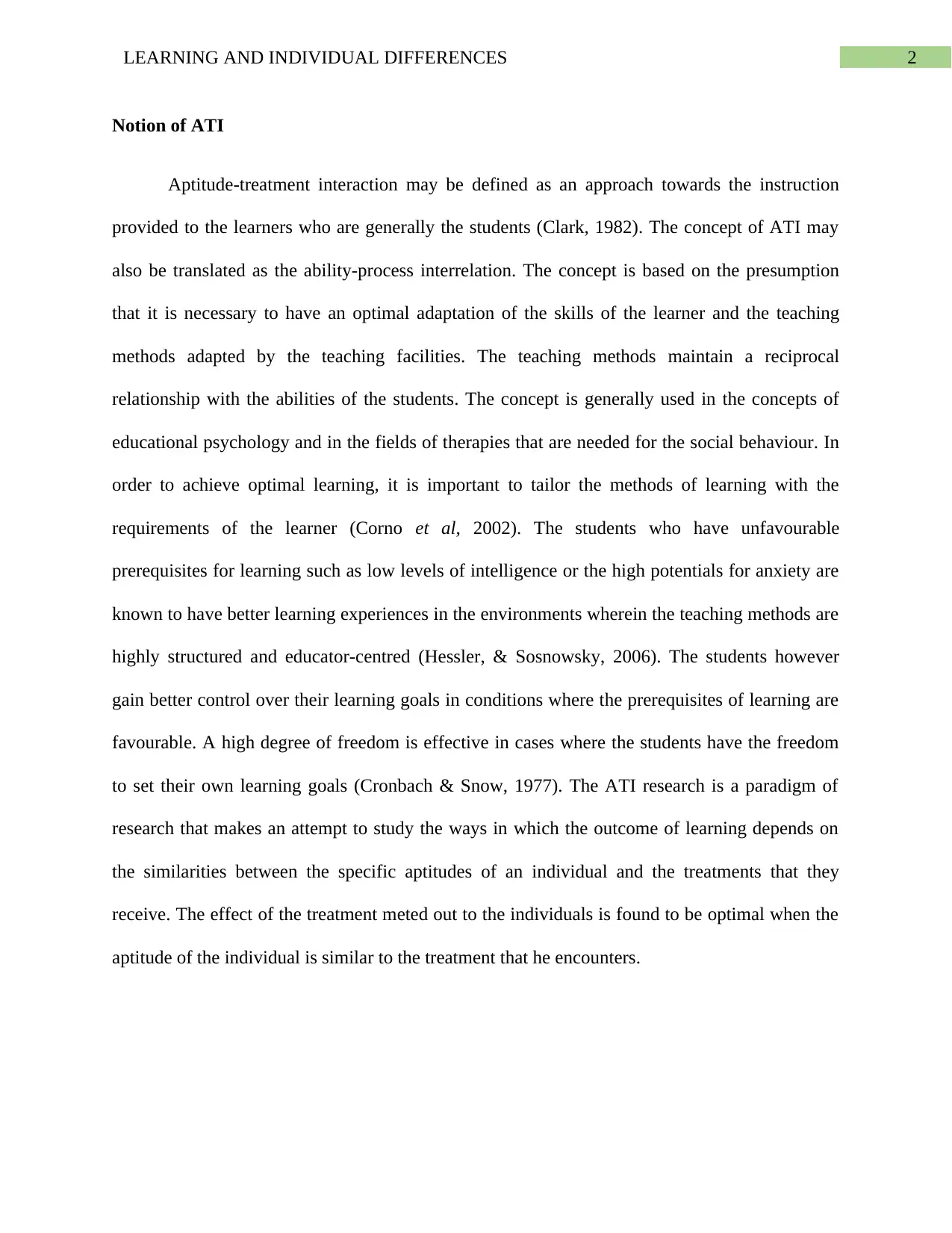
2LEARNING AND INDIVIDUAL DIFFERENCES
Notion of ATI
Aptitude-treatment interaction may be defined as an approach towards the instruction
provided to the learners who are generally the students (Clark, 1982). The concept of ATI may
also be translated as the ability-process interrelation. The concept is based on the presumption
that it is necessary to have an optimal adaptation of the skills of the learner and the teaching
methods adapted by the teaching facilities. The teaching methods maintain a reciprocal
relationship with the abilities of the students. The concept is generally used in the concepts of
educational psychology and in the fields of therapies that are needed for the social behaviour. In
order to achieve optimal learning, it is important to tailor the methods of learning with the
requirements of the learner (Corno et al, 2002). The students who have unfavourable
prerequisites for learning such as low levels of intelligence or the high potentials for anxiety are
known to have better learning experiences in the environments wherein the teaching methods are
highly structured and educator-centred (Hessler, & Sosnowsky, 2006). The students however
gain better control over their learning goals in conditions where the prerequisites of learning are
favourable. A high degree of freedom is effective in cases where the students have the freedom
to set their own learning goals (Cronbach & Snow, 1977). The ATI research is a paradigm of
research that makes an attempt to study the ways in which the outcome of learning depends on
the similarities between the specific aptitudes of an individual and the treatments that they
receive. The effect of the treatment meted out to the individuals is found to be optimal when the
aptitude of the individual is similar to the treatment that he encounters.
Notion of ATI
Aptitude-treatment interaction may be defined as an approach towards the instruction
provided to the learners who are generally the students (Clark, 1982). The concept of ATI may
also be translated as the ability-process interrelation. The concept is based on the presumption
that it is necessary to have an optimal adaptation of the skills of the learner and the teaching
methods adapted by the teaching facilities. The teaching methods maintain a reciprocal
relationship with the abilities of the students. The concept is generally used in the concepts of
educational psychology and in the fields of therapies that are needed for the social behaviour. In
order to achieve optimal learning, it is important to tailor the methods of learning with the
requirements of the learner (Corno et al, 2002). The students who have unfavourable
prerequisites for learning such as low levels of intelligence or the high potentials for anxiety are
known to have better learning experiences in the environments wherein the teaching methods are
highly structured and educator-centred (Hessler, & Sosnowsky, 2006). The students however
gain better control over their learning goals in conditions where the prerequisites of learning are
favourable. A high degree of freedom is effective in cases where the students have the freedom
to set their own learning goals (Cronbach & Snow, 1977). The ATI research is a paradigm of
research that makes an attempt to study the ways in which the outcome of learning depends on
the similarities between the specific aptitudes of an individual and the treatments that they
receive. The effect of the treatment meted out to the individuals is found to be optimal when the
aptitude of the individual is similar to the treatment that he encounters.
⊘ This is a preview!⊘
Do you want full access?
Subscribe today to unlock all pages.

Trusted by 1+ million students worldwide
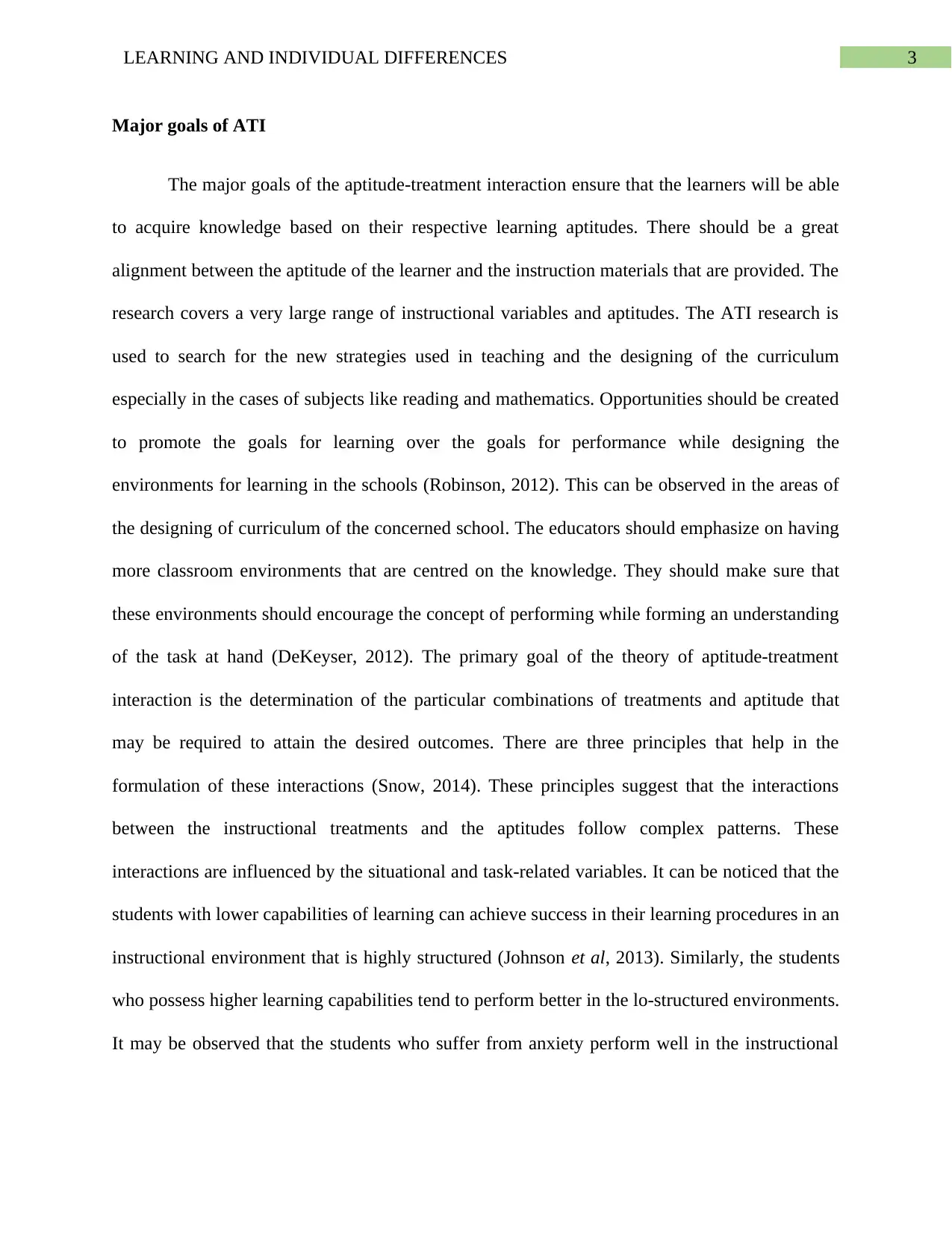
3LEARNING AND INDIVIDUAL DIFFERENCES
Major goals of ATI
The major goals of the aptitude-treatment interaction ensure that the learners will be able
to acquire knowledge based on their respective learning aptitudes. There should be a great
alignment between the aptitude of the learner and the instruction materials that are provided. The
research covers a very large range of instructional variables and aptitudes. The ATI research is
used to search for the new strategies used in teaching and the designing of the curriculum
especially in the cases of subjects like reading and mathematics. Opportunities should be created
to promote the goals for learning over the goals for performance while designing the
environments for learning in the schools (Robinson, 2012). This can be observed in the areas of
the designing of curriculum of the concerned school. The educators should emphasize on having
more classroom environments that are centred on the knowledge. They should make sure that
these environments should encourage the concept of performing while forming an understanding
of the task at hand (DeKeyser, 2012). The primary goal of the theory of aptitude-treatment
interaction is the determination of the particular combinations of treatments and aptitude that
may be required to attain the desired outcomes. There are three principles that help in the
formulation of these interactions (Snow, 2014). These principles suggest that the interactions
between the instructional treatments and the aptitudes follow complex patterns. These
interactions are influenced by the situational and task-related variables. It can be noticed that the
students with lower capabilities of learning can achieve success in their learning procedures in an
instructional environment that is highly structured (Johnson et al, 2013). Similarly, the students
who possess higher learning capabilities tend to perform better in the lo-structured environments.
It may be observed that the students who suffer from anxiety perform well in the instructional
Major goals of ATI
The major goals of the aptitude-treatment interaction ensure that the learners will be able
to acquire knowledge based on their respective learning aptitudes. There should be a great
alignment between the aptitude of the learner and the instruction materials that are provided. The
research covers a very large range of instructional variables and aptitudes. The ATI research is
used to search for the new strategies used in teaching and the designing of the curriculum
especially in the cases of subjects like reading and mathematics. Opportunities should be created
to promote the goals for learning over the goals for performance while designing the
environments for learning in the schools (Robinson, 2012). This can be observed in the areas of
the designing of curriculum of the concerned school. The educators should emphasize on having
more classroom environments that are centred on the knowledge. They should make sure that
these environments should encourage the concept of performing while forming an understanding
of the task at hand (DeKeyser, 2012). The primary goal of the theory of aptitude-treatment
interaction is the determination of the particular combinations of treatments and aptitude that
may be required to attain the desired outcomes. There are three principles that help in the
formulation of these interactions (Snow, 2014). These principles suggest that the interactions
between the instructional treatments and the aptitudes follow complex patterns. These
interactions are influenced by the situational and task-related variables. It can be noticed that the
students with lower capabilities of learning can achieve success in their learning procedures in an
instructional environment that is highly structured (Johnson et al, 2013). Similarly, the students
who possess higher learning capabilities tend to perform better in the lo-structured environments.
It may be observed that the students who suffer from anxiety perform well in the instructional
Paraphrase This Document
Need a fresh take? Get an instant paraphrase of this document with our AI Paraphraser
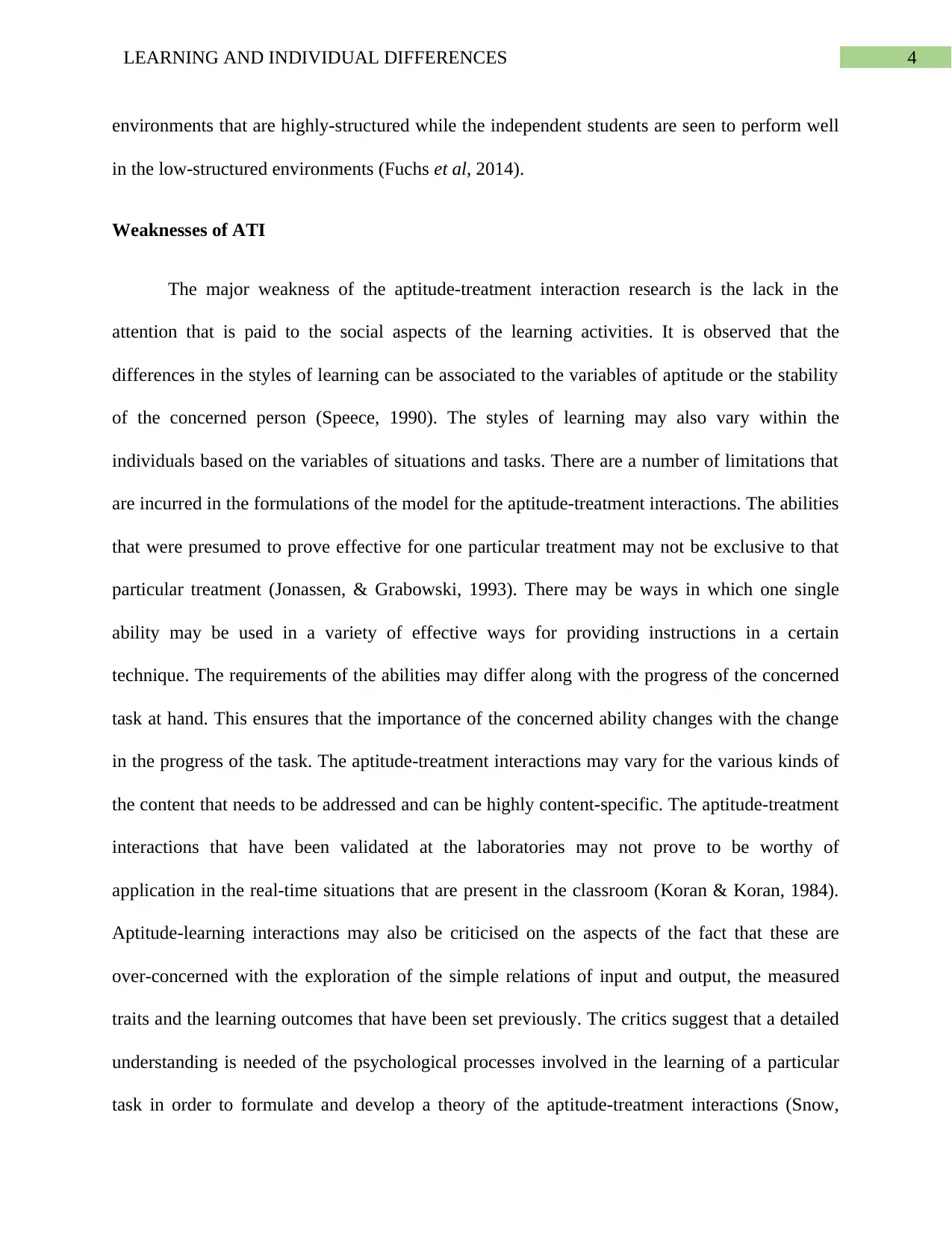
4LEARNING AND INDIVIDUAL DIFFERENCES
environments that are highly-structured while the independent students are seen to perform well
in the low-structured environments (Fuchs et al, 2014).
Weaknesses of ATI
The major weakness of the aptitude-treatment interaction research is the lack in the
attention that is paid to the social aspects of the learning activities. It is observed that the
differences in the styles of learning can be associated to the variables of aptitude or the stability
of the concerned person (Speece, 1990). The styles of learning may also vary within the
individuals based on the variables of situations and tasks. There are a number of limitations that
are incurred in the formulations of the model for the aptitude-treatment interactions. The abilities
that were presumed to prove effective for one particular treatment may not be exclusive to that
particular treatment (Jonassen, & Grabowski, 1993). There may be ways in which one single
ability may be used in a variety of effective ways for providing instructions in a certain
technique. The requirements of the abilities may differ along with the progress of the concerned
task at hand. This ensures that the importance of the concerned ability changes with the change
in the progress of the task. The aptitude-treatment interactions may vary for the various kinds of
the content that needs to be addressed and can be highly content-specific. The aptitude-treatment
interactions that have been validated at the laboratories may not prove to be worthy of
application in the real-time situations that are present in the classroom (Koran & Koran, 1984).
Aptitude-learning interactions may also be criticised on the aspects of the fact that these are
over-concerned with the exploration of the simple relations of input and output, the measured
traits and the learning outcomes that have been set previously. The critics suggest that a detailed
understanding is needed of the psychological processes involved in the learning of a particular
task in order to formulate and develop a theory of the aptitude-treatment interactions (Snow,
environments that are highly-structured while the independent students are seen to perform well
in the low-structured environments (Fuchs et al, 2014).
Weaknesses of ATI
The major weakness of the aptitude-treatment interaction research is the lack in the
attention that is paid to the social aspects of the learning activities. It is observed that the
differences in the styles of learning can be associated to the variables of aptitude or the stability
of the concerned person (Speece, 1990). The styles of learning may also vary within the
individuals based on the variables of situations and tasks. There are a number of limitations that
are incurred in the formulations of the model for the aptitude-treatment interactions. The abilities
that were presumed to prove effective for one particular treatment may not be exclusive to that
particular treatment (Jonassen, & Grabowski, 1993). There may be ways in which one single
ability may be used in a variety of effective ways for providing instructions in a certain
technique. The requirements of the abilities may differ along with the progress of the concerned
task at hand. This ensures that the importance of the concerned ability changes with the change
in the progress of the task. The aptitude-treatment interactions may vary for the various kinds of
the content that needs to be addressed and can be highly content-specific. The aptitude-treatment
interactions that have been validated at the laboratories may not prove to be worthy of
application in the real-time situations that are present in the classroom (Koran & Koran, 1984).
Aptitude-learning interactions may also be criticised on the aspects of the fact that these are
over-concerned with the exploration of the simple relations of input and output, the measured
traits and the learning outcomes that have been set previously. The critics suggest that a detailed
understanding is needed of the psychological processes involved in the learning of a particular
task in order to formulate and develop a theory of the aptitude-treatment interactions (Snow,
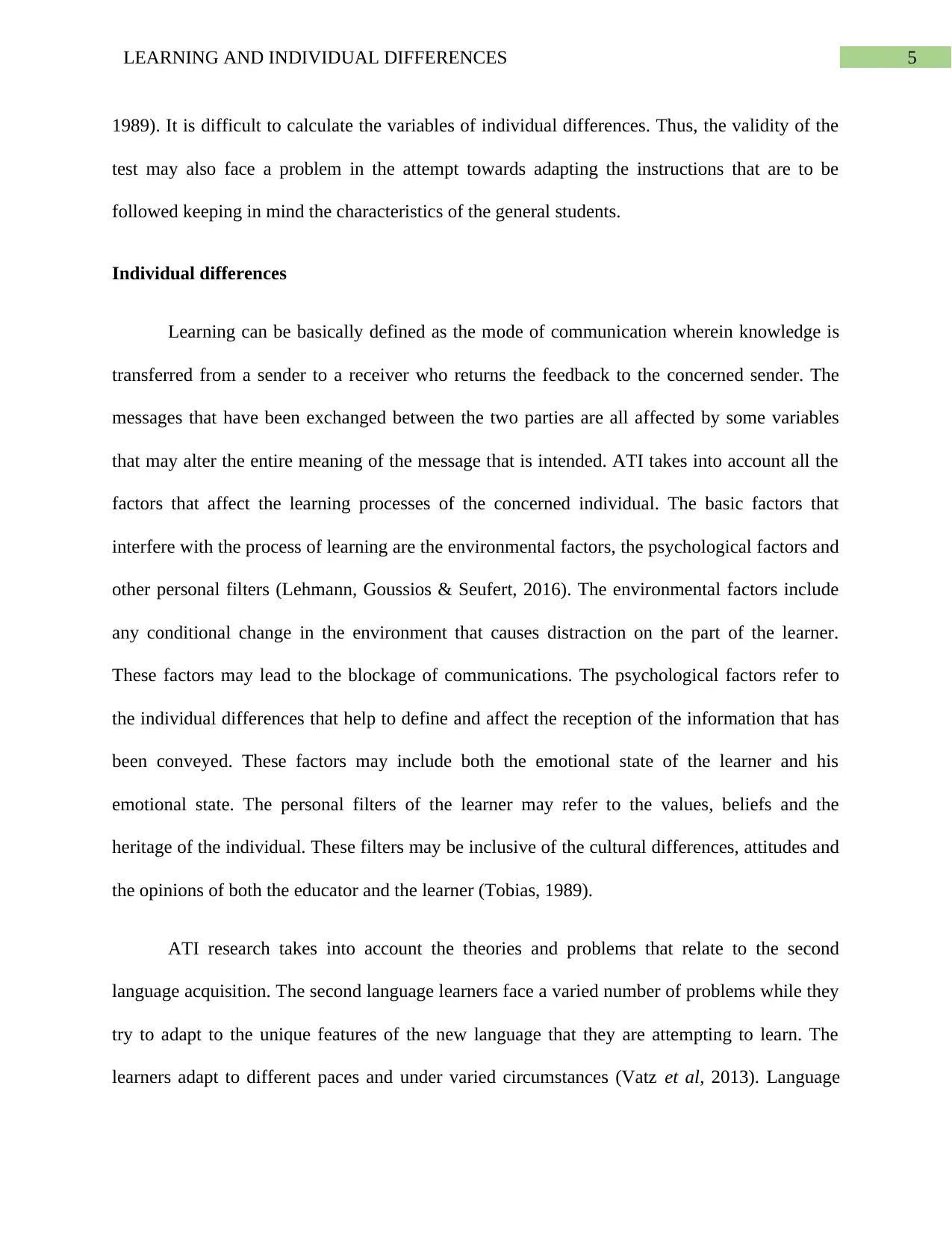
5LEARNING AND INDIVIDUAL DIFFERENCES
1989). It is difficult to calculate the variables of individual differences. Thus, the validity of the
test may also face a problem in the attempt towards adapting the instructions that are to be
followed keeping in mind the characteristics of the general students.
Individual differences
Learning can be basically defined as the mode of communication wherein knowledge is
transferred from a sender to a receiver who returns the feedback to the concerned sender. The
messages that have been exchanged between the two parties are all affected by some variables
that may alter the entire meaning of the message that is intended. ATI takes into account all the
factors that affect the learning processes of the concerned individual. The basic factors that
interfere with the process of learning are the environmental factors, the psychological factors and
other personal filters (Lehmann, Goussios & Seufert, 2016). The environmental factors include
any conditional change in the environment that causes distraction on the part of the learner.
These factors may lead to the blockage of communications. The psychological factors refer to
the individual differences that help to define and affect the reception of the information that has
been conveyed. These factors may include both the emotional state of the learner and his
emotional state. The personal filters of the learner may refer to the values, beliefs and the
heritage of the individual. These filters may be inclusive of the cultural differences, attitudes and
the opinions of both the educator and the learner (Tobias, 1989).
ATI research takes into account the theories and problems that relate to the second
language acquisition. The second language learners face a varied number of problems while they
try to adapt to the unique features of the new language that they are attempting to learn. The
learners adapt to different paces and under varied circumstances (Vatz et al, 2013). Language
1989). It is difficult to calculate the variables of individual differences. Thus, the validity of the
test may also face a problem in the attempt towards adapting the instructions that are to be
followed keeping in mind the characteristics of the general students.
Individual differences
Learning can be basically defined as the mode of communication wherein knowledge is
transferred from a sender to a receiver who returns the feedback to the concerned sender. The
messages that have been exchanged between the two parties are all affected by some variables
that may alter the entire meaning of the message that is intended. ATI takes into account all the
factors that affect the learning processes of the concerned individual. The basic factors that
interfere with the process of learning are the environmental factors, the psychological factors and
other personal filters (Lehmann, Goussios & Seufert, 2016). The environmental factors include
any conditional change in the environment that causes distraction on the part of the learner.
These factors may lead to the blockage of communications. The psychological factors refer to
the individual differences that help to define and affect the reception of the information that has
been conveyed. These factors may include both the emotional state of the learner and his
emotional state. The personal filters of the learner may refer to the values, beliefs and the
heritage of the individual. These filters may be inclusive of the cultural differences, attitudes and
the opinions of both the educator and the learner (Tobias, 1989).
ATI research takes into account the theories and problems that relate to the second
language acquisition. The second language learners face a varied number of problems while they
try to adapt to the unique features of the new language that they are attempting to learn. The
learners adapt to different paces and under varied circumstances (Vatz et al, 2013). Language
⊘ This is a preview!⊘
Do you want full access?
Subscribe today to unlock all pages.

Trusted by 1+ million students worldwide
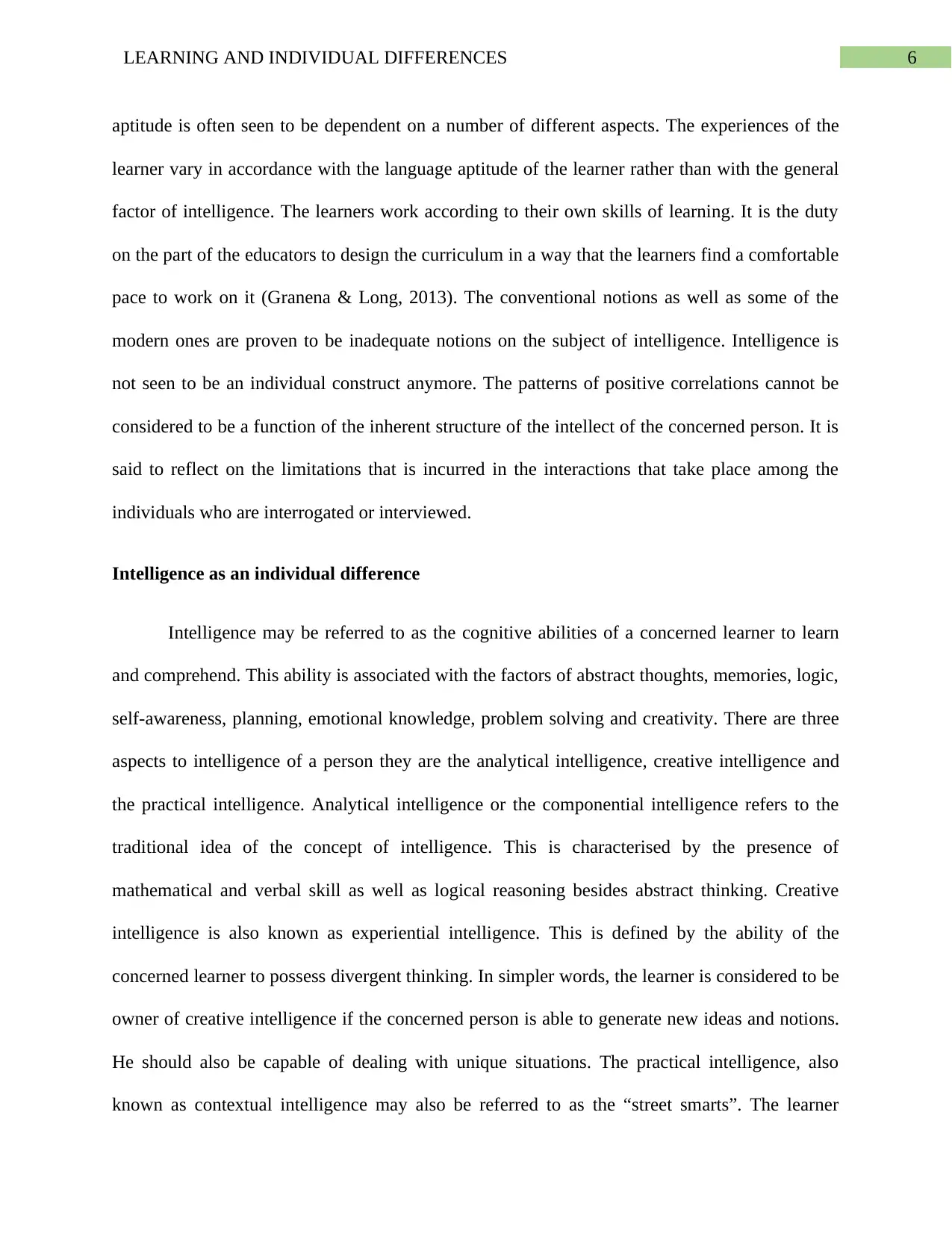
6LEARNING AND INDIVIDUAL DIFFERENCES
aptitude is often seen to be dependent on a number of different aspects. The experiences of the
learner vary in accordance with the language aptitude of the learner rather than with the general
factor of intelligence. The learners work according to their own skills of learning. It is the duty
on the part of the educators to design the curriculum in a way that the learners find a comfortable
pace to work on it (Granena & Long, 2013). The conventional notions as well as some of the
modern ones are proven to be inadequate notions on the subject of intelligence. Intelligence is
not seen to be an individual construct anymore. The patterns of positive correlations cannot be
considered to be a function of the inherent structure of the intellect of the concerned person. It is
said to reflect on the limitations that is incurred in the interactions that take place among the
individuals who are interrogated or interviewed.
Intelligence as an individual difference
Intelligence may be referred to as the cognitive abilities of a concerned learner to learn
and comprehend. This ability is associated with the factors of abstract thoughts, memories, logic,
self-awareness, planning, emotional knowledge, problem solving and creativity. There are three
aspects to intelligence of a person they are the analytical intelligence, creative intelligence and
the practical intelligence. Analytical intelligence or the componential intelligence refers to the
traditional idea of the concept of intelligence. This is characterised by the presence of
mathematical and verbal skill as well as logical reasoning besides abstract thinking. Creative
intelligence is also known as experiential intelligence. This is defined by the ability of the
concerned learner to possess divergent thinking. In simpler words, the learner is considered to be
owner of creative intelligence if the concerned person is able to generate new ideas and notions.
He should also be capable of dealing with unique situations. The practical intelligence, also
known as contextual intelligence may also be referred to as the “street smarts”. The learner
aptitude is often seen to be dependent on a number of different aspects. The experiences of the
learner vary in accordance with the language aptitude of the learner rather than with the general
factor of intelligence. The learners work according to their own skills of learning. It is the duty
on the part of the educators to design the curriculum in a way that the learners find a comfortable
pace to work on it (Granena & Long, 2013). The conventional notions as well as some of the
modern ones are proven to be inadequate notions on the subject of intelligence. Intelligence is
not seen to be an individual construct anymore. The patterns of positive correlations cannot be
considered to be a function of the inherent structure of the intellect of the concerned person. It is
said to reflect on the limitations that is incurred in the interactions that take place among the
individuals who are interrogated or interviewed.
Intelligence as an individual difference
Intelligence may be referred to as the cognitive abilities of a concerned learner to learn
and comprehend. This ability is associated with the factors of abstract thoughts, memories, logic,
self-awareness, planning, emotional knowledge, problem solving and creativity. There are three
aspects to intelligence of a person they are the analytical intelligence, creative intelligence and
the practical intelligence. Analytical intelligence or the componential intelligence refers to the
traditional idea of the concept of intelligence. This is characterised by the presence of
mathematical and verbal skill as well as logical reasoning besides abstract thinking. Creative
intelligence is also known as experiential intelligence. This is defined by the ability of the
concerned learner to possess divergent thinking. In simpler words, the learner is considered to be
owner of creative intelligence if the concerned person is able to generate new ideas and notions.
He should also be capable of dealing with unique situations. The practical intelligence, also
known as contextual intelligence may also be referred to as the “street smarts”. The learner
Paraphrase This Document
Need a fresh take? Get an instant paraphrase of this document with our AI Paraphraser
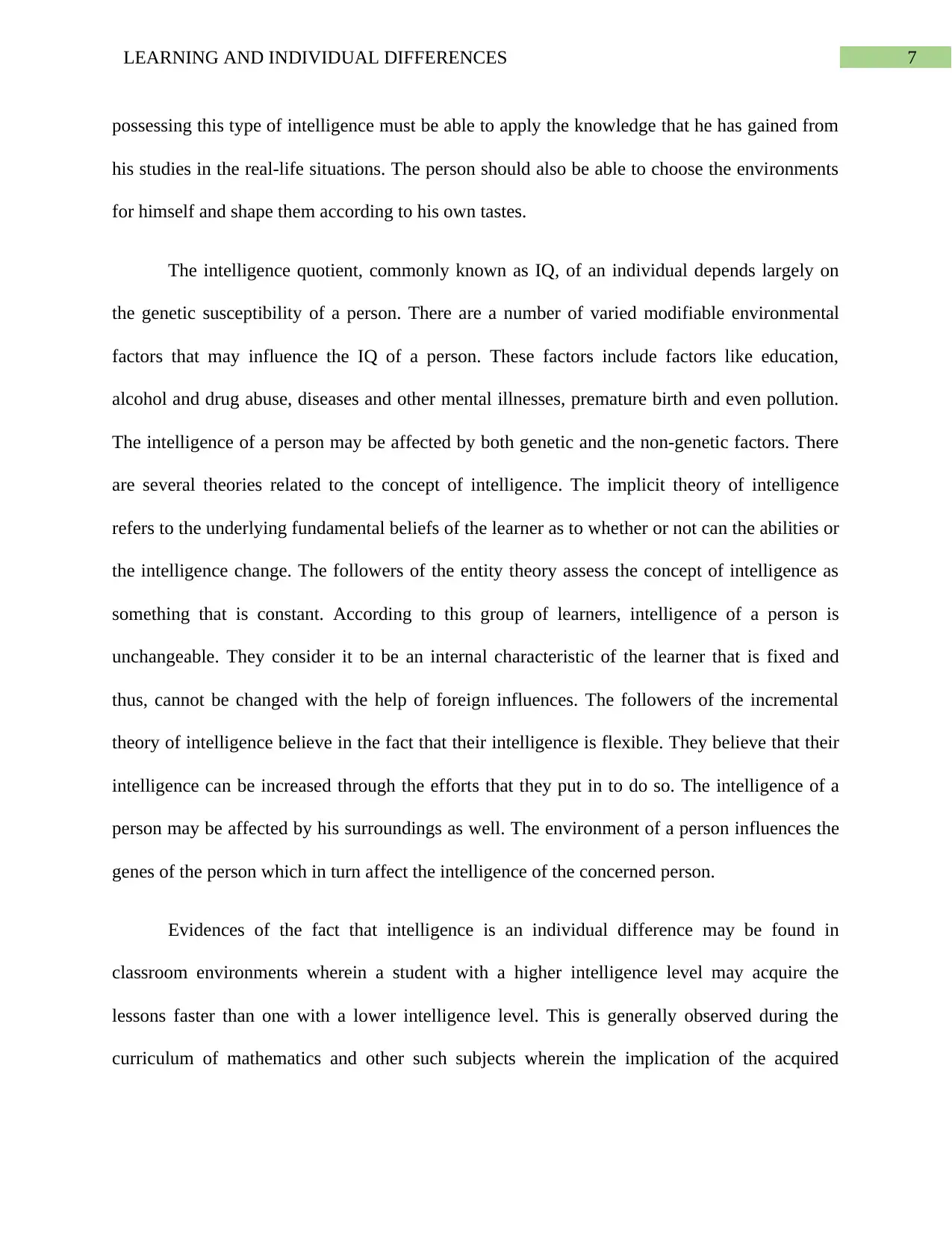
7LEARNING AND INDIVIDUAL DIFFERENCES
possessing this type of intelligence must be able to apply the knowledge that he has gained from
his studies in the real-life situations. The person should also be able to choose the environments
for himself and shape them according to his own tastes.
The intelligence quotient, commonly known as IQ, of an individual depends largely on
the genetic susceptibility of a person. There are a number of varied modifiable environmental
factors that may influence the IQ of a person. These factors include factors like education,
alcohol and drug abuse, diseases and other mental illnesses, premature birth and even pollution.
The intelligence of a person may be affected by both genetic and the non-genetic factors. There
are several theories related to the concept of intelligence. The implicit theory of intelligence
refers to the underlying fundamental beliefs of the learner as to whether or not can the abilities or
the intelligence change. The followers of the entity theory assess the concept of intelligence as
something that is constant. According to this group of learners, intelligence of a person is
unchangeable. They consider it to be an internal characteristic of the learner that is fixed and
thus, cannot be changed with the help of foreign influences. The followers of the incremental
theory of intelligence believe in the fact that their intelligence is flexible. They believe that their
intelligence can be increased through the efforts that they put in to do so. The intelligence of a
person may be affected by his surroundings as well. The environment of a person influences the
genes of the person which in turn affect the intelligence of the concerned person.
Evidences of the fact that intelligence is an individual difference may be found in
classroom environments wherein a student with a higher intelligence level may acquire the
lessons faster than one with a lower intelligence level. This is generally observed during the
curriculum of mathematics and other such subjects wherein the implication of the acquired
possessing this type of intelligence must be able to apply the knowledge that he has gained from
his studies in the real-life situations. The person should also be able to choose the environments
for himself and shape them according to his own tastes.
The intelligence quotient, commonly known as IQ, of an individual depends largely on
the genetic susceptibility of a person. There are a number of varied modifiable environmental
factors that may influence the IQ of a person. These factors include factors like education,
alcohol and drug abuse, diseases and other mental illnesses, premature birth and even pollution.
The intelligence of a person may be affected by both genetic and the non-genetic factors. There
are several theories related to the concept of intelligence. The implicit theory of intelligence
refers to the underlying fundamental beliefs of the learner as to whether or not can the abilities or
the intelligence change. The followers of the entity theory assess the concept of intelligence as
something that is constant. According to this group of learners, intelligence of a person is
unchangeable. They consider it to be an internal characteristic of the learner that is fixed and
thus, cannot be changed with the help of foreign influences. The followers of the incremental
theory of intelligence believe in the fact that their intelligence is flexible. They believe that their
intelligence can be increased through the efforts that they put in to do so. The intelligence of a
person may be affected by his surroundings as well. The environment of a person influences the
genes of the person which in turn affect the intelligence of the concerned person.
Evidences of the fact that intelligence is an individual difference may be found in
classroom environments wherein a student with a higher intelligence level may acquire the
lessons faster than one with a lower intelligence level. This is generally observed during the
curriculum of mathematics and other such subjects wherein the implication of the acquired
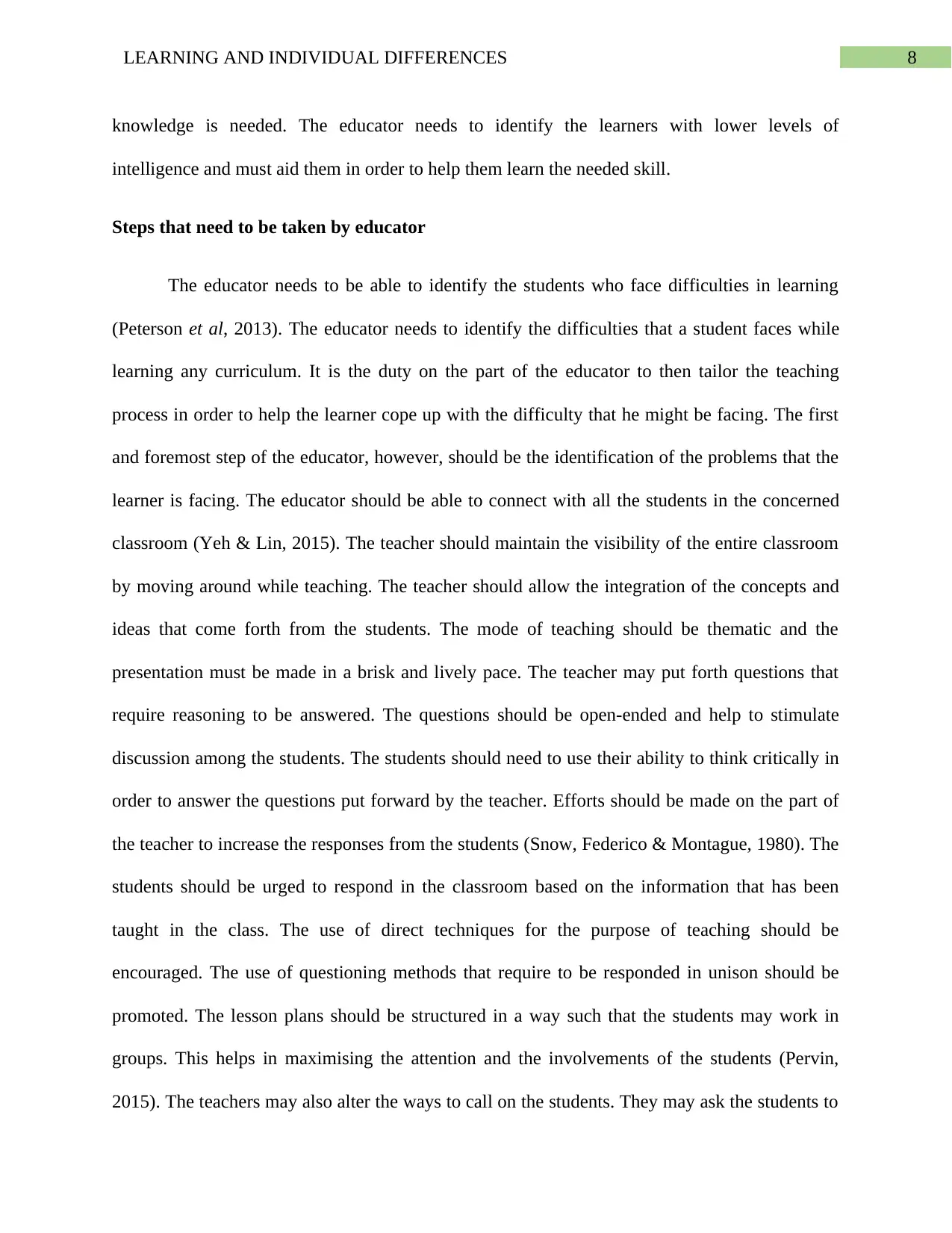
8LEARNING AND INDIVIDUAL DIFFERENCES
knowledge is needed. The educator needs to identify the learners with lower levels of
intelligence and must aid them in order to help them learn the needed skill.
Steps that need to be taken by educator
The educator needs to be able to identify the students who face difficulties in learning
(Peterson et al, 2013). The educator needs to identify the difficulties that a student faces while
learning any curriculum. It is the duty on the part of the educator to then tailor the teaching
process in order to help the learner cope up with the difficulty that he might be facing. The first
and foremost step of the educator, however, should be the identification of the problems that the
learner is facing. The educator should be able to connect with all the students in the concerned
classroom (Yeh & Lin, 2015). The teacher should maintain the visibility of the entire classroom
by moving around while teaching. The teacher should allow the integration of the concepts and
ideas that come forth from the students. The mode of teaching should be thematic and the
presentation must be made in a brisk and lively pace. The teacher may put forth questions that
require reasoning to be answered. The questions should be open-ended and help to stimulate
discussion among the students. The students should need to use their ability to think critically in
order to answer the questions put forward by the teacher. Efforts should be made on the part of
the teacher to increase the responses from the students (Snow, Federico & Montague, 1980). The
students should be urged to respond in the classroom based on the information that has been
taught in the class. The use of direct techniques for the purpose of teaching should be
encouraged. The use of questioning methods that require to be responded in unison should be
promoted. The lesson plans should be structured in a way such that the students may work in
groups. This helps in maximising the attention and the involvements of the students (Pervin,
2015). The teachers may also alter the ways to call on the students. They may ask the students to
knowledge is needed. The educator needs to identify the learners with lower levels of
intelligence and must aid them in order to help them learn the needed skill.
Steps that need to be taken by educator
The educator needs to be able to identify the students who face difficulties in learning
(Peterson et al, 2013). The educator needs to identify the difficulties that a student faces while
learning any curriculum. It is the duty on the part of the educator to then tailor the teaching
process in order to help the learner cope up with the difficulty that he might be facing. The first
and foremost step of the educator, however, should be the identification of the problems that the
learner is facing. The educator should be able to connect with all the students in the concerned
classroom (Yeh & Lin, 2015). The teacher should maintain the visibility of the entire classroom
by moving around while teaching. The teacher should allow the integration of the concepts and
ideas that come forth from the students. The mode of teaching should be thematic and the
presentation must be made in a brisk and lively pace. The teacher may put forth questions that
require reasoning to be answered. The questions should be open-ended and help to stimulate
discussion among the students. The students should need to use their ability to think critically in
order to answer the questions put forward by the teacher. Efforts should be made on the part of
the teacher to increase the responses from the students (Snow, Federico & Montague, 1980). The
students should be urged to respond in the classroom based on the information that has been
taught in the class. The use of direct techniques for the purpose of teaching should be
encouraged. The use of questioning methods that require to be responded in unison should be
promoted. The lesson plans should be structured in a way such that the students may work in
groups. This helps in maximising the attention and the involvements of the students (Pervin,
2015). The teachers may also alter the ways to call on the students. They may ask the students to
⊘ This is a preview!⊘
Do you want full access?
Subscribe today to unlock all pages.

Trusted by 1+ million students worldwide
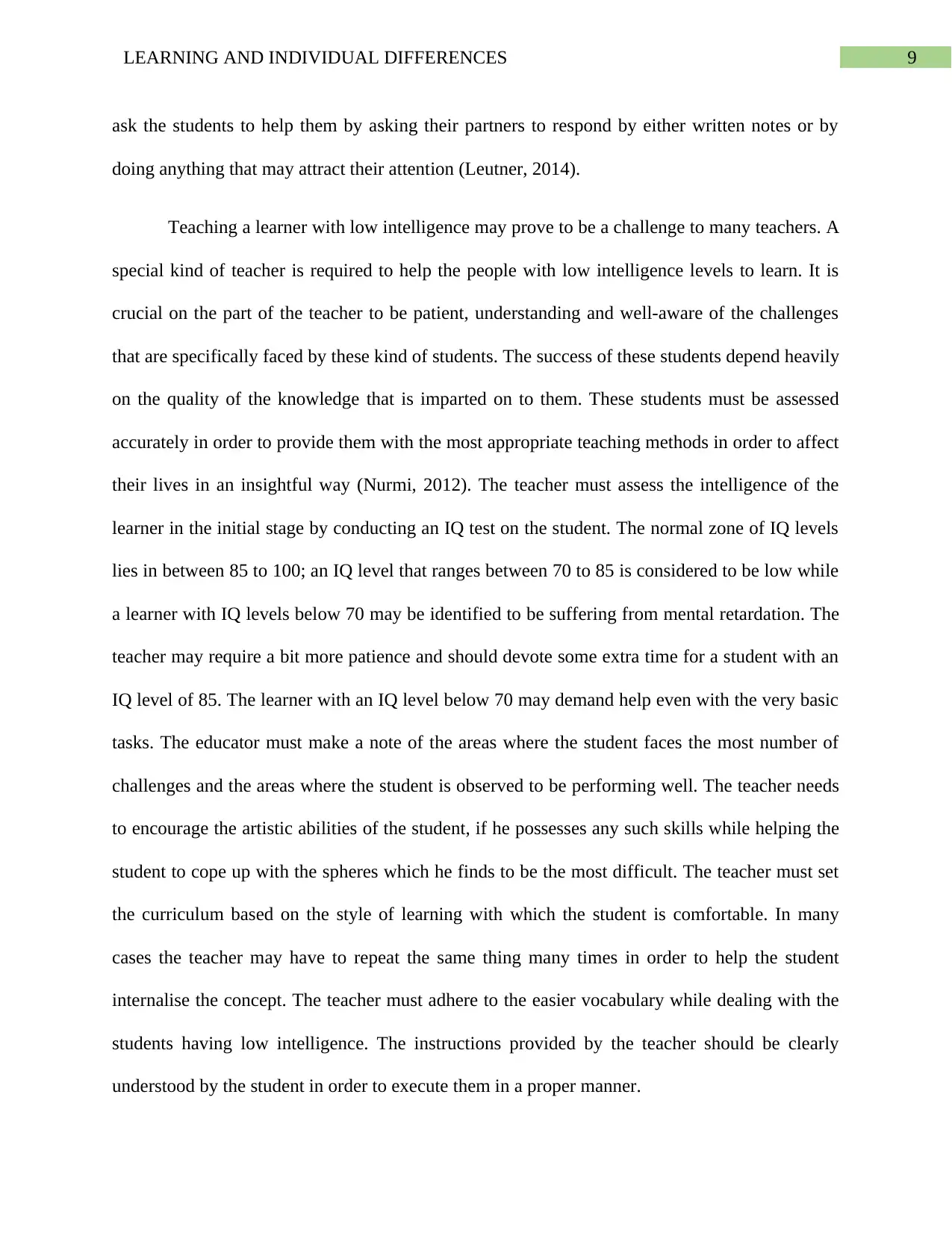
9LEARNING AND INDIVIDUAL DIFFERENCES
ask the students to help them by asking their partners to respond by either written notes or by
doing anything that may attract their attention (Leutner, 2014).
Teaching a learner with low intelligence may prove to be a challenge to many teachers. A
special kind of teacher is required to help the people with low intelligence levels to learn. It is
crucial on the part of the teacher to be patient, understanding and well-aware of the challenges
that are specifically faced by these kind of students. The success of these students depend heavily
on the quality of the knowledge that is imparted on to them. These students must be assessed
accurately in order to provide them with the most appropriate teaching methods in order to affect
their lives in an insightful way (Nurmi, 2012). The teacher must assess the intelligence of the
learner in the initial stage by conducting an IQ test on the student. The normal zone of IQ levels
lies in between 85 to 100; an IQ level that ranges between 70 to 85 is considered to be low while
a learner with IQ levels below 70 may be identified to be suffering from mental retardation. The
teacher may require a bit more patience and should devote some extra time for a student with an
IQ level of 85. The learner with an IQ level below 70 may demand help even with the very basic
tasks. The educator must make a note of the areas where the student faces the most number of
challenges and the areas where the student is observed to be performing well. The teacher needs
to encourage the artistic abilities of the student, if he possesses any such skills while helping the
student to cope up with the spheres which he finds to be the most difficult. The teacher must set
the curriculum based on the style of learning with which the student is comfortable. In many
cases the teacher may have to repeat the same thing many times in order to help the student
internalise the concept. The teacher must adhere to the easier vocabulary while dealing with the
students having low intelligence. The instructions provided by the teacher should be clearly
understood by the student in order to execute them in a proper manner.
ask the students to help them by asking their partners to respond by either written notes or by
doing anything that may attract their attention (Leutner, 2014).
Teaching a learner with low intelligence may prove to be a challenge to many teachers. A
special kind of teacher is required to help the people with low intelligence levels to learn. It is
crucial on the part of the teacher to be patient, understanding and well-aware of the challenges
that are specifically faced by these kind of students. The success of these students depend heavily
on the quality of the knowledge that is imparted on to them. These students must be assessed
accurately in order to provide them with the most appropriate teaching methods in order to affect
their lives in an insightful way (Nurmi, 2012). The teacher must assess the intelligence of the
learner in the initial stage by conducting an IQ test on the student. The normal zone of IQ levels
lies in between 85 to 100; an IQ level that ranges between 70 to 85 is considered to be low while
a learner with IQ levels below 70 may be identified to be suffering from mental retardation. The
teacher may require a bit more patience and should devote some extra time for a student with an
IQ level of 85. The learner with an IQ level below 70 may demand help even with the very basic
tasks. The educator must make a note of the areas where the student faces the most number of
challenges and the areas where the student is observed to be performing well. The teacher needs
to encourage the artistic abilities of the student, if he possesses any such skills while helping the
student to cope up with the spheres which he finds to be the most difficult. The teacher must set
the curriculum based on the style of learning with which the student is comfortable. In many
cases the teacher may have to repeat the same thing many times in order to help the student
internalise the concept. The teacher must adhere to the easier vocabulary while dealing with the
students having low intelligence. The instructions provided by the teacher should be clearly
understood by the student in order to execute them in a proper manner.
Paraphrase This Document
Need a fresh take? Get an instant paraphrase of this document with our AI Paraphraser
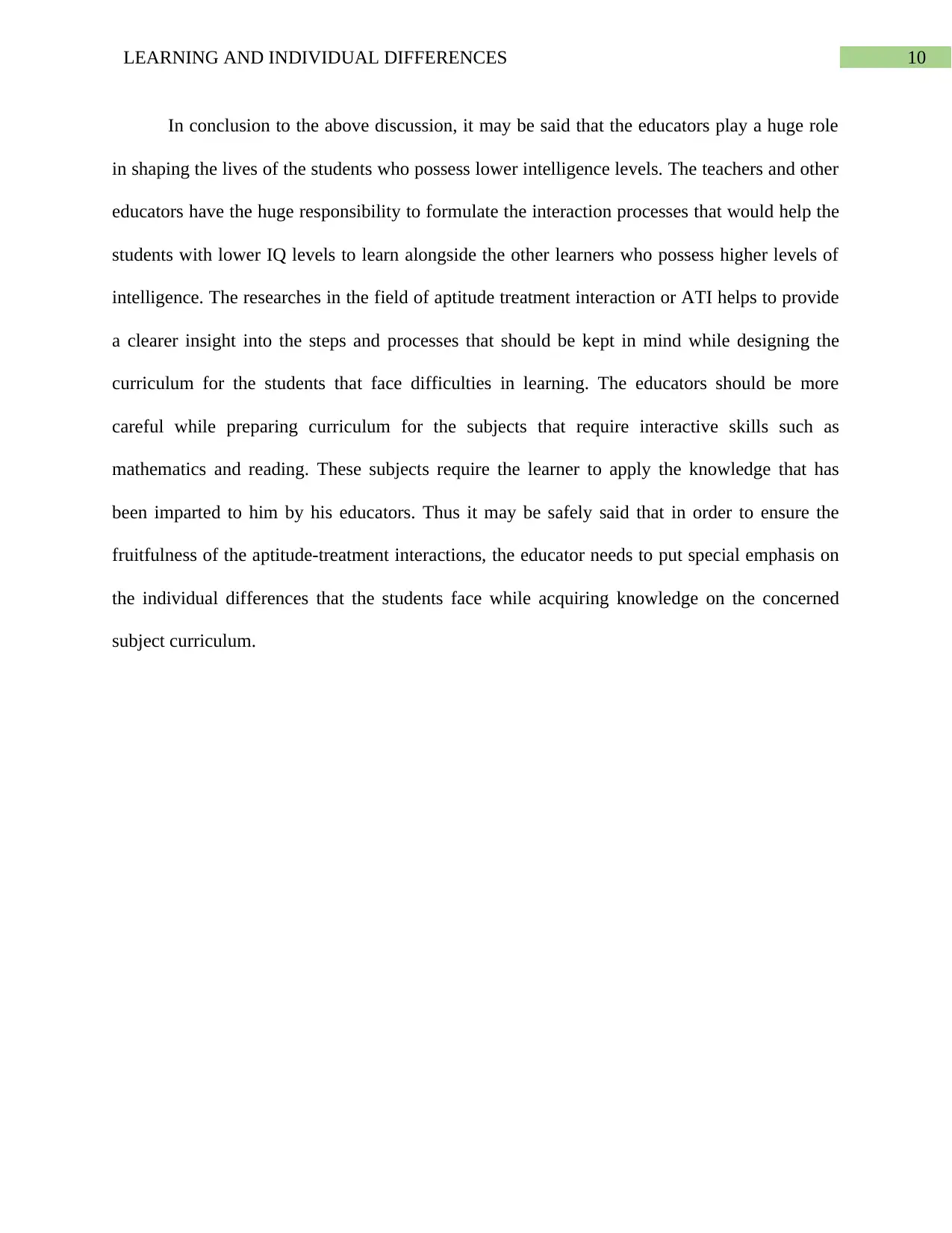
10LEARNING AND INDIVIDUAL DIFFERENCES
In conclusion to the above discussion, it may be said that the educators play a huge role
in shaping the lives of the students who possess lower intelligence levels. The teachers and other
educators have the huge responsibility to formulate the interaction processes that would help the
students with lower IQ levels to learn alongside the other learners who possess higher levels of
intelligence. The researches in the field of aptitude treatment interaction or ATI helps to provide
a clearer insight into the steps and processes that should be kept in mind while designing the
curriculum for the students that face difficulties in learning. The educators should be more
careful while preparing curriculum for the subjects that require interactive skills such as
mathematics and reading. These subjects require the learner to apply the knowledge that has
been imparted to him by his educators. Thus it may be safely said that in order to ensure the
fruitfulness of the aptitude-treatment interactions, the educator needs to put special emphasis on
the individual differences that the students face while acquiring knowledge on the concerned
subject curriculum.
In conclusion to the above discussion, it may be said that the educators play a huge role
in shaping the lives of the students who possess lower intelligence levels. The teachers and other
educators have the huge responsibility to formulate the interaction processes that would help the
students with lower IQ levels to learn alongside the other learners who possess higher levels of
intelligence. The researches in the field of aptitude treatment interaction or ATI helps to provide
a clearer insight into the steps and processes that should be kept in mind while designing the
curriculum for the students that face difficulties in learning. The educators should be more
careful while preparing curriculum for the subjects that require interactive skills such as
mathematics and reading. These subjects require the learner to apply the knowledge that has
been imparted to him by his educators. Thus it may be safely said that in order to ensure the
fruitfulness of the aptitude-treatment interactions, the educator needs to put special emphasis on
the individual differences that the students face while acquiring knowledge on the concerned
subject curriculum.
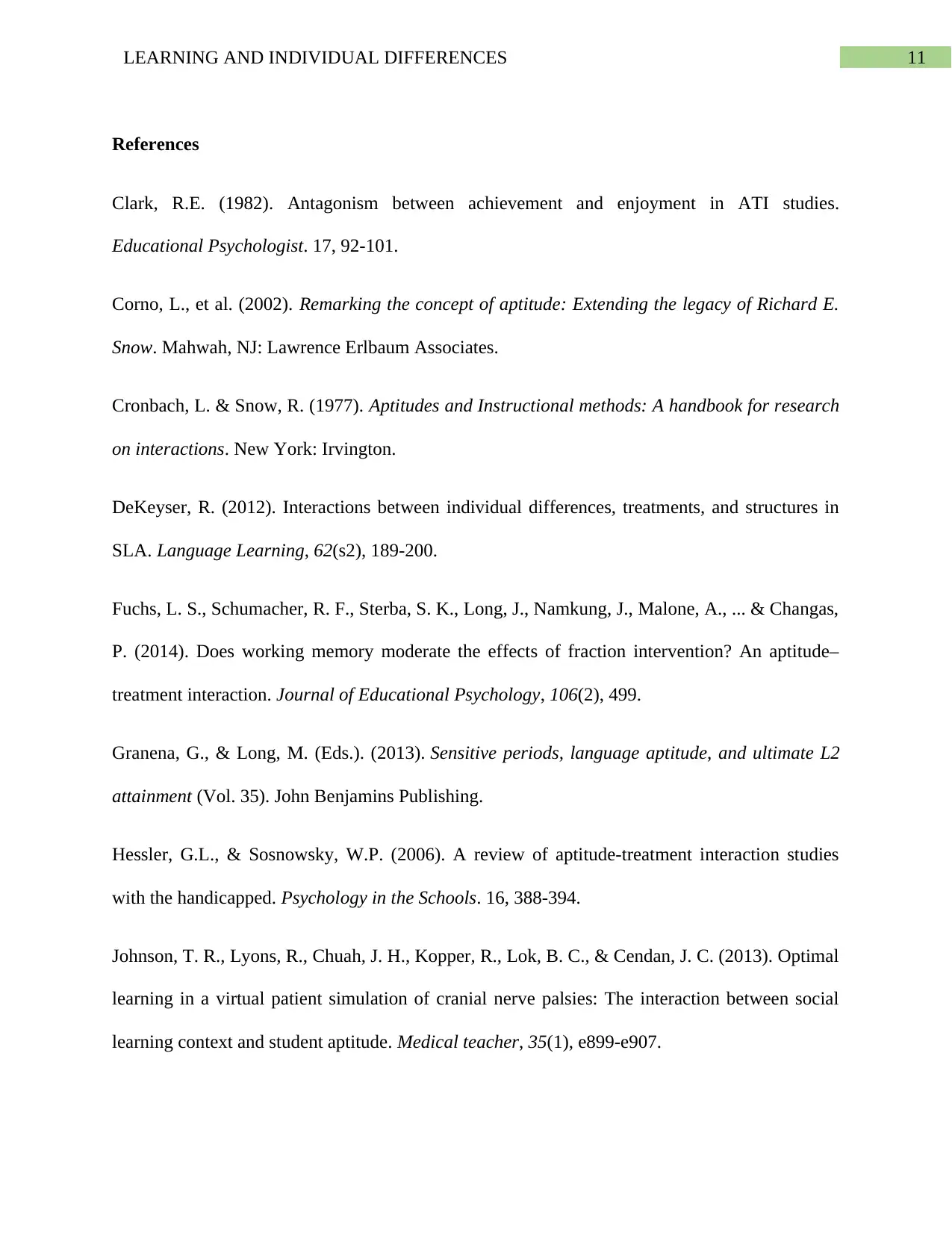
11LEARNING AND INDIVIDUAL DIFFERENCES
References
Clark, R.E. (1982). Antagonism between achievement and enjoyment in ATI studies.
Educational Psychologist. 17, 92-101.
Corno, L., et al. (2002). Remarking the concept of aptitude: Extending the legacy of Richard E.
Snow. Mahwah, NJ: Lawrence Erlbaum Associates.
Cronbach, L. & Snow, R. (1977). Aptitudes and Instructional methods: A handbook for research
on interactions. New York: Irvington.
DeKeyser, R. (2012). Interactions between individual differences, treatments, and structures in
SLA. Language Learning, 62(s2), 189-200.
Fuchs, L. S., Schumacher, R. F., Sterba, S. K., Long, J., Namkung, J., Malone, A., ... & Changas,
P. (2014). Does working memory moderate the effects of fraction intervention? An aptitude–
treatment interaction. Journal of Educational Psychology, 106(2), 499.
Granena, G., & Long, M. (Eds.). (2013). Sensitive periods, language aptitude, and ultimate L2
attainment (Vol. 35). John Benjamins Publishing.
Hessler, G.L., & Sosnowsky, W.P. (2006). A review of aptitude-treatment interaction studies
with the handicapped. Psychology in the Schools. 16, 388-394.
Johnson, T. R., Lyons, R., Chuah, J. H., Kopper, R., Lok, B. C., & Cendan, J. C. (2013). Optimal
learning in a virtual patient simulation of cranial nerve palsies: The interaction between social
learning context and student aptitude. Medical teacher, 35(1), e899-e907.
References
Clark, R.E. (1982). Antagonism between achievement and enjoyment in ATI studies.
Educational Psychologist. 17, 92-101.
Corno, L., et al. (2002). Remarking the concept of aptitude: Extending the legacy of Richard E.
Snow. Mahwah, NJ: Lawrence Erlbaum Associates.
Cronbach, L. & Snow, R. (1977). Aptitudes and Instructional methods: A handbook for research
on interactions. New York: Irvington.
DeKeyser, R. (2012). Interactions between individual differences, treatments, and structures in
SLA. Language Learning, 62(s2), 189-200.
Fuchs, L. S., Schumacher, R. F., Sterba, S. K., Long, J., Namkung, J., Malone, A., ... & Changas,
P. (2014). Does working memory moderate the effects of fraction intervention? An aptitude–
treatment interaction. Journal of Educational Psychology, 106(2), 499.
Granena, G., & Long, M. (Eds.). (2013). Sensitive periods, language aptitude, and ultimate L2
attainment (Vol. 35). John Benjamins Publishing.
Hessler, G.L., & Sosnowsky, W.P. (2006). A review of aptitude-treatment interaction studies
with the handicapped. Psychology in the Schools. 16, 388-394.
Johnson, T. R., Lyons, R., Chuah, J. H., Kopper, R., Lok, B. C., & Cendan, J. C. (2013). Optimal
learning in a virtual patient simulation of cranial nerve palsies: The interaction between social
learning context and student aptitude. Medical teacher, 35(1), e899-e907.
⊘ This is a preview!⊘
Do you want full access?
Subscribe today to unlock all pages.

Trusted by 1+ million students worldwide
1 out of 14
Related Documents
Your All-in-One AI-Powered Toolkit for Academic Success.
+13062052269
info@desklib.com
Available 24*7 on WhatsApp / Email
![[object Object]](/_next/static/media/star-bottom.7253800d.svg)
Unlock your academic potential
Copyright © 2020–2025 A2Z Services. All Rights Reserved. Developed and managed by ZUCOL.





